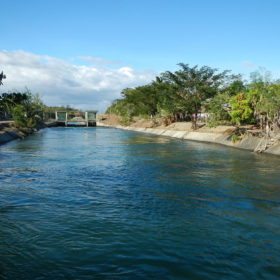
The country’s National Irrigation Administration will bet on floating PV and solar-powered irrigation to improve water and energy supply. The Pantabangan and Casecnan dams, in the province of Nueva Ecija in the Central Luzon region, have been identified as ideal locations for floating solar.
The Philippines’ National Irrigation Administration (NIA) is planning to invest in more floating PV projects, as well as hydropower, to improve the water supply for irrigation.
The government agency said floating solar projects will be encouraged as they have less environmental impact during construction than hydropower infrastructure and require minimal use of heavy equipment. “The solar panels installed over the reservoir can help reduce the amount of water lost due to evaporation, which becomes particularly useful in times of drought and El Niño,” the NIA stated. “Similarly, the panels are intentionally spaced out so that there can still be enough sunlight that can filter through for fish and other organisms to grow.”
The Pantabangan and Casecnan dams, in the province of Nueva Ecija in the Central Luzon region, were identified as ideal locations for floating solar. “Thus, NIA offers its dams and reservoirs for water-based projects which can achieve the same purpose, of increasing power production, while saving agricultural lands and providing additional income to the government,” the agency said.
Pilot
The organization added, there is already a 200 kW pilot project in the country, commissioned by the SN Aboitiz Power hydropower joint venture between Norwegian renewables company SN Power AS and Philippines-based energy company AboitizPower, which is a unit of Aboitiz Equity Ventures.
The NIA said it has identified 379 potential hydroelectric power sites nationwide which could host solar and wind power facilities. The agency also pledged to ramp up the use of solar-powered irrigation systems such as the one near La Libertad, in Negros Oriental province, which waters 25ha of corn. “The system has five stations, each with 10 panels capable of irrigating three to five hectares of agricultural land,” said the agency. “The technology consists of solar panels, pumps, electronic pump controllers, storage tanks and conveyor systems.”
Pumps
Another under-construction project, in Sofronio Española in Palawan province, irrigates 10ha of agricultural land. “It was designed as an energy-efficient project that has the ability to pump up water from the source to an elevated storage tank and releases by gravity directly to irrigated areas,” the NIA stated. A third solar irrigation project was built in the province of Camarines Sur to help rain-dependent farmers plant rice in three cropping seasons. The solar system at Barangay Malawag – the Aguik-ican Malawag Solar-Powered Irrigation System – cost PHP6 million ($122,000) and can pump an average 1,000m3 in 6-8 hours. Powered by 60 solar panels, the irrigation system can discharge 35.42 liters per second, with the supply pipe able to discharge 20.62 liters per second.
The United Nations Industrial Development Organization recently said it was seeking to support the seaweed industry on the Philippine island of Tawi-Tawi – in the Bangsamoro autonomous region in Muslim Mindanao, at the southernmost frontier of the country – through aquavoltaic projects. The organization is bringing power access to one of the least electrified areas of the archipelago, with solar-plus-storage chosen as the cheapest and most efficient source.
Lắp đặt điện mặt trời Khải Minh Tech
https://ift.tt/2X7bF6x
0906633505
info.khaiminhtech@gmail.com
80/39 Trần Quang Diệu, Phường 14, Quận 3
Lắp đặt điện mặt trời Khải Minh Tech
https://ift.tt/2ZH4TRU
Không có nhận xét nào:
Đăng nhận xét